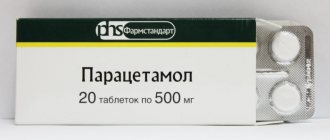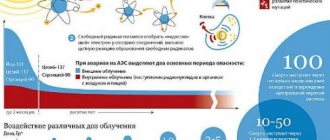A person is exposed to radiation from birth, but does not even suspect it, since his eye does not see radiation rays. Living organisms have no benefit from radiation and its effect on humans is exclusively negative. There are types of radiation that differ from each other in the degree of danger and harmfulness. There are also methods that can help reduce the impact of these harmful rays. It is impossible to protect yourself completely, but it is quite possible to protect yourself at least a little.
Where can you encounter radiation?
Radiation follows people everywhere. The earth itself has a natural radiation background. It may vary depending on the region. The highest level of radiation in our country is observed in the Altai Territory . But even it is so small that it is considered completely safe. Much more dangerous are artificially created sources of ionizing radiation, which we encounter quite often:
- X-ray equipment in hospitals. Every year we undergo fluorographic examination and are exposed to radiation. The dose of radiation in x-rays is small and a single procedure does not cause any harm to health.
- Scanning devices at airports. They work similarly to medical x-rays. The rays pass through the human body, so the radiation dose is extremely small.
- Screens of old televisions equipped with cathode ray tubes.
- Nuclear power plant reactors. This is the most powerful source. As long as it is intact, it does not pose any particular danger. But any damage to it threatens a global catastrophe.
- Radioactive waste. If they are disposed of incorrectly, the environment may be contaminated, which poses a potential danger.
A normal dose of radiation does not pose a great danger to human life or health .
If it is slightly exceeded, radiation sickness develops. If a person is exposed to a large dose of radiation, instant death occurs.
Types of background radiation
Ionizing radiation (IR), interacting with matter, causes the ionization of atoms and molecules (the atom is excited and opens from individual electrons from atomic shells). Main types of radiation:
- Alpha radiation. Corpuscular, presented in the form of a stream of heavy positively charged α-particles. They are heavy, their range in the substance is short, so they can be held up by a sheet of paper and a layer of dead skin.
- Beta radiation. Also corpuscular, presented in the form of a stream of electrons or positrons that are emitted during the radioactive beta decay of atomic nuclei.
- Neutron. Corpuscular is a stream of neutrons that does not have an ionizing effect, but a serious ionizing effect is observed due to elastic and inelastic scattering on the nuclei of matter.
- Gamma and X-ray radiation. Electromagnetic, differ in the mechanism of occurrence. X-ray is capable of penetrating all substances and is presented in the form of electromagnetic radiation with wavelengths from 10-12 to 10-7. Gamma radiation is of intranuclear origin, arising during the decay of radioactive nuclei, during the interaction of fast charged particles with matter, and under other circumstances. Has high penetrating ability.
How is radiation measured?
Radioactivity in the surrounding area directly affects health. Even while at home, a person can be negatively affected. Apartments that contain dishes made from tap glass, finishing materials with the addition of granite, or old radiation paint are especially dangerous .
Under such circumstances, it is important to periodically measure background radiation. Special devices - radiometers or dosimeters - will help to identify a dangerous background. For use in a residential area, a dosimeter is used. Using a radiometer, you can easily determine the background of food products.
Today there are special organizations that provide services to determine radiation contamination. Specialists will help identify and dispose of background sources.
You can also purchase a home dosimeter. But you cannot be 100% confident in the readings of such a device. When using it, you must strictly follow the instructions and avoid contact of the device with the objects under study. If indoor radiation levels prove unacceptable, you should seek professional help as soon as possible .
Sources of radiation and its use
Ionizing radiation in the environment can arise due to either natural or artificial processes. Natural sources of radiation include solar and cosmic radiation, as well as radiation from certain radioactive materials such as uranium. Such radioactive raw materials are mined in the depths of the earth and used in medicine and industry. Sometimes radioactive materials enter the environment as a result of industrial accidents and in industries that use radioactive raw materials. Most often this occurs due to non-compliance with safety rules for storing and working with radioactive materials or due to the absence of such rules.
The radiation dose rate of uranium glass beads, equal to 0.46 μSv/h, is approximately five times higher than natural background ionizing radiation
It is worth noting that until recently, radioactive materials were not considered hazardous to health, and on the contrary, they were used as healing drugs, and they were also valued for their beautiful glow. Uranium glass
is an example of radioactive material used for decorative purposes. This glass glows fluorescent green due to the addition of uranium oxide. The percentage of uranium in this glass is relatively small and the amount of radiation it emits is small, so uranium glass is currently considered safe for health. They even make glasses, plates, and other utensils from it. Uranium glass is prized for its unusual glow. The sun emits ultraviolet light, so uranium glass glows in sunlight, although this glow is much more pronounced under ultraviolet light lamps.
The radiation dose rate of granite, equal to 0.38 μSv/h, is approximately four times higher than natural background ionizing radiation
Radiation has many uses, from generating electricity to treating cancer patients. In this article, we will discuss how radiation affects tissues and cells in humans, animals, and biomaterials, with a particular focus on how quickly and how severely damage occurs to irradiated cells and tissues.
Degree of exposure to radiation on humans
The table will help you understand the question of what dose of radiation is dangerous for humans.
| Radiation dose, Sv | Impact on humans |
| Up to 0.05 | Permissible radiation doses. With such exposure, no negative consequences for human health are observed. |
| From 0.05 to 0.2 | Symptoms of radiation sickness do not appear. In the future, the likelihood of developing cancer, as well as genetic mutations in offspring, increases. |
| From 0.2 to 0.5 | No negative symptoms are observed. The concentration of leukocytes in the blood decreases. |
| From 0.5 to 1 | The first signs of radiation sickness appear. In men, the likelihood of infertility increases many times over. |
| From 1 to 2 | Severe form of radiation sickness. Based on statistics, 10% of people who receive such a dose of radiation live no more than a month. In the first 10 days, the victim’s condition is stable, after which a sharp deterioration in health occurs. |
| From 2 to 3 | The probability of death within the first month increases to 35%. The concentration of blood leukocytes drops to critical levels. |
| From 3 to 6 | The possibility of cure remains. About 60% of victims die. The cause of death is the development of infectious diseases and internal bleeding. |
| From 6 to 10 | The probability of death is 100%. It is impossible to recover in this case. Modern medicine manages to delay death by a maximum of a year. |
| From 10 to 80 | The person falls into a deep coma. Death occurs half an hour later. |
| More than 80 | Death from radiation occurs instantly. |
Radiation whose power does not exceed 0.2 microsieverts per hour is considered safe . The permissible dose of radiation for humans does not exceed 0.05 Sv. Exposure above this level leads to serious health consequences. An annual X-ray dose of 0.05 Sv is typical for people working at nuclear power plants, provided there are no emergency situations.
When performing local medical procedures, the maximum permitted radiation dose for humans is 0.3 Sv. The rate of x-ray exposure per year does not exceed two procedures.
Not only the radiation power plays a role, but also the duration of exposure. A low-intensity exposure that lasts for a long time will be more detrimental to health than a short-term, high-intensity exposure. But this is only true if we are not talking about lethal doses of radiation.
Is there even a safe dose?
There is no safety threshold; this was established by the scientist R. Siewert back in 1950. Specific numbers can describe a range; their impact can only be predicted approximately. Even a small, permissible dose can cause somatic or genetic changes.
The difficulty is that it is not always possible to see damage immediately; they appear some time later.
All this complicates the study of the issue and forces scientists to adhere to cautious, approximate estimates. That is why the safe level of radiation for humans is a range of values.
Radiation accumulation effect
Over the course of a lifetime, the human body can accumulate from 100 to 700 microsieverts of radiation. This indicator is considered normal and does not threaten human health or life. At the same time, about 3 to 4 microsieverts can accumulate in the body per year.
The amount of accumulated radiation will largely depend on external circumstances. Thus, each x-ray in a dentist’s office brings 0.2 microsieverts, a passage through an airport scanner – 0.001 mSv, and a fluorographic examination – 3 mSv.
When does radiation sickness develop?
The consequence of exposure to a critical dose of radiation on a person is the development of radiation sickness. It affects almost all body systems . Depending on the dose, radiation can be treatable or fatal.
According to recent studies, the dangerous dose of radiation per year to cause radiation sickness is 1.5 Sv. The permissible dose limit for a single exposure is 0.5 Sv. After this mark, signs of damage begin to appear.
The following forms of radiation sickness are distinguished:
- Radiation injury. Appears if the dose of one-time radiation does not exceed 1 Sv.
- Bone marrow form. Dangerous standards – from 1 to 6 Sv. In half of the cases, this form of the disease leads to death.
- The gastrointestinal form is observed at radiation dosages of 10 to 20 Sv. Accompanied by internal bleeding, fever, and the development of infectious lesions.
- Vascular form. Develops after exposure to radiation ranging from 20 to 80 Sv. Severe hemodynamic disturbances occur.
- Cerebral form. Observed with irradiation above 80 Sv. Instant brain swelling and death of the victim occurs.
In some cases, radiation sickness can develop into a chronic form. The period of its formation can take up to three years . After this, the body is restored, which lasts another three years. With proper therapy, the result is cure. But in some cases it is not possible to save the patient.
Units
You can often find “the normal background radiation is 0.5 microsieverts/hour”, “the norm is up to 50 micro-roentgens per hour”. Why are the units of measurement different and how do they relate to each other? The value can often be the same, for example 1 Sievert = 1 Gray. But many units have different semantic content.
There are 5 main units in total:
- Renten – the unit is non-systemic. 1 R = 1 BER, 1 R is approximately equal to 0.0098 Sv.
- RER is an outdated measure of the same thing, the dose affecting living organisms as X-rays or gamma rays with a power of 1 R. 1 RER = 0.01 Sv.
- Gray - absorbed. 1 Gray corresponds to 1 Joule of radiation energy per mass of 1 kg. 1 Gy = 100 Rad = 1 J/kg.
- Rad is a non-systemic unit. Also shows the dose of absorbed radiation per 1 kg. 1 rad is 0.01 J per 1 kg (1 rad = 0.01 Gy).
- Sievert – equivalent. 1 Sv, which equals 1 Gy, is equal to 1 J/1 kg or 100 RER.
For example: 10 mSv (millisieverts) = 0.01 Sv = 0.01 Gy = 1 Rad = 1 BER = 1 R.
Gray and Sievert are written in the SI system.
Symptoms of radiation sickness
If the normal dose of radiation is not exceeded critically, then symptoms of radiation injury appear. Among them are:
- Attacks of nausea and vomiting.
- Dryness of the mucous surfaces of the nasopharynx.
- There is a bitter taste in the mouth.
- Severe headaches appear.
- The victim quickly gets tired, his vitality leaves him.
- Blood pressure decreases.
If the radiation dose exceeds 10 Sv, the following symptoms are observed:
- Redness of certain areas of the skin. Over time, they acquire a blue tint.
- The frequency of contraction of the heart muscle changes.
- Muscle tone decreases.
- Tremors appear in the fingers.
- The tendon reflex disappears.
After four days, severe symptoms disappear. The disease becomes latent. Its duration will depend on the degree of damage to the body. At the same time, all reflexes of the body are significantly reduced, and symptoms of a neuralgic nature appear.
If the radiation dose exceeded 3 pollutants, then after two weeks intense baldness begins . At a dose above 10 Sv, the disease immediately enters the third phase. A serious change in blood composition is observed, and infectious diseases develop. In the shortest possible time, cerebral edema occurs and muscle tone completely disappears. In the vast majority of cases, the person dies.
At the first suspicious symptoms, you should seek help from a doctor. Only with timely treatment is there a chance of successful treatment of radiation sickness.
Diagnostics
The appearance of radiation sickness is detected based on primary symptoms. Close attention is paid to patients who have been in a situation where the safe dose of radiation was exceeded.
The severity of the injury is determined by examining blood samples from the victim.
The presence of anemia, reticulocytopenia, leukopenia, and ESR is determined. The presence of radiation sickness is indicated by signs of bleeding in the myelogram .
In addition to blood tests, the following diagnostic measures are carried out:
- Taking scrapings of skin ulcers and performing microscopy.
- EEG.
- Ultrasound of the abdominal cavity.
- Ultrasound of the thyroid gland.
- Ultrasound of the pelvic organs.
At the same time, consultations are held with specialized specialists: hematologist, endocrinologist, neurologist and gastroenterologist . They carefully study the clinical picture of the disease and the results of all examinations.
Therapy for radiation sickness
The disease can be successfully treated if the dose threshold for infection is exceeded slightly . Among the main therapeutic techniques are:
- Timely provision of first aid. This is especially important for people who have been to a place of severe radiation contamination. All clothing is removed from the victim, as it accumulates radiation. Wash the body and stomach thoroughly.
- Drug therapy. It includes the use of sedatives, antihistamines, antibiotics, and agents for restoring the gastrointestinal tract. In addition, treatment is carried out aimed at restoring the immune system. At the third stage of the disease, antihemorrhagic drugs are prescribed, among other things.
- Blood transfusion.
- Physiotherapy. The most common method of breathing is using an oxygen mask.
- Exercise therapy.
- In some cases, specialists perform a bone marrow transplant.
- Proper nutrition. First of all, an optimal drinking regime is organized. The victim should drink at least two liters of water per day. His diet should also include juices and tea. However, you should not drink at the same time as eating. The consumption of fatty, fried and overly salty foods is minimized. There should be at least five meals a day. The consumption of alcoholic beverages is strictly prohibited.
Only full compliance with all the recommendations of specialists gives the victim a chance for recovery. A period of 12 weeks is considered critical . If the victim managed to overcome it, then recovery will most likely occur.
Preventive actions
In order to avoid becoming a victim of radiation treatment, you must adhere to the following recommendations:
- Avoid potentially hazardous areas . At the slightest suspicion that there is a maximum dose of radiation in the area, you should immediately leave this place and contact specialists.
- People employed in hazardous industries are advised to take vitamin and mineral complexes, as well as other medications that support the immune system. The choice of specific medications should be made in conjunction with your doctor.
- When contacting radioactive objects, it is necessary to use specialized protective equipment: suits, respirators, and so on.
- Drink as much water as possible. The liquid helps flush out radioactive substances from the body .
The lethal dose of radiation in sieverts is only 6 units. Therefore, at the first suspicion of an increased background, it is necessary to conduct a study using a dosimeter.
Who sets the standards?
The issues of regulation and control in the Russian Federation are dealt with by specialists from the State Committee for Sanitary and Epidemiological Supervision. The SanPiN standards take into account the recommendations of international organizations.
Documentation:
- NRB-99. This is the main document. Standards are prescribed separately for the civilian population and workers whose work involves contact with sources of radiation.
- OSPOR-99.











